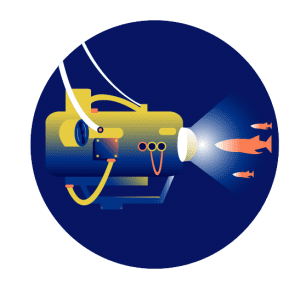MECOPO
Robotic exploration of biodiversity on south Pacific seamounts
The Pacific Ocean has the largest number of seamounts and oceanic islands in the world. These topographic features harbor ecosystems that are particularly vulnerable to anthropogenic impacts.
MECOPO focuses on the understudied but key marine biodiversity of these areas at depths of 60 to 350 m using a remotely operated underwater vehicle.
The state of biodiversity in the ocean is a major societal concern as it is currently experiencing multiple stressors associated with anthropogenic activities and climate change. While marine ecosystems in populated coastal zones are altered, it is not clear how remote systems respond to these stressors. MECOPO focuses on the benthic mesophotic ((attached to the substrate at 60 – 350 m depth) communities, an understudied key component of marine biodiversity in oceanic islands and seamounts.
Ariadna and her team will characterize and compare these communities on oceanic islands and surrounding seamounts in two South East Pacific areas: Easter Island (EI) and Desventuradas Islands (DI). They will first create a database of species inhabiting the selected islands. The data will then be interpreted, in light of current ecological theories and ocean model simulations, in order to describe, for the first time, biological connections between the different seamounts.
This will help identify which areas are likely to be sensitive to anthropogenic changes (e.g., potential modification in oceanographic current that modify patterns of larval dispersion, destruction of stepping stones habitats for settlement and reproduction) and the effects they could have on the communities (e.g., decrease of biodiversity, appearance of new species, migration to deeper/shallower areas or even extinction of species).
This database will be a critical asset for management decisions for these highly vulnerable and relatively preserved ecosystems, providing, in particular, science-based material for discussing the creation of new Marine Protected Areas.
PROJECT GOAL
Discover how sea stars and urchins from mesophotic communities (60 to 350 m deep) disperse and connect between oceanic islands and seamounts along the South Pacific Ocean.
Understand what areas could be more sensitive to anthropogenic and natural changes and their potential recovery after perturbations.
Location
South East Pacific
the Desventuradas Islands & Easter Island and their surrounding seamounts
Project leader
Dr. Ariadna Mecho, ESMOI, Universidad Católica del Norte
Partner
OCEANA Chile
The Fishermen and the Community of Rapa-Nui
Scientific partners
Millennium Nucleus for Ecology and Sustainable Management of Oceanic Islands (ESMOI)
Institut de Recherche pour le Développement (IRD)


